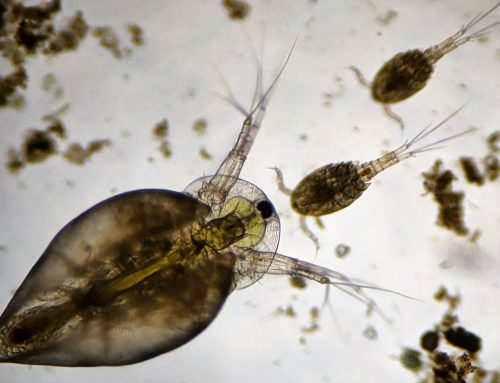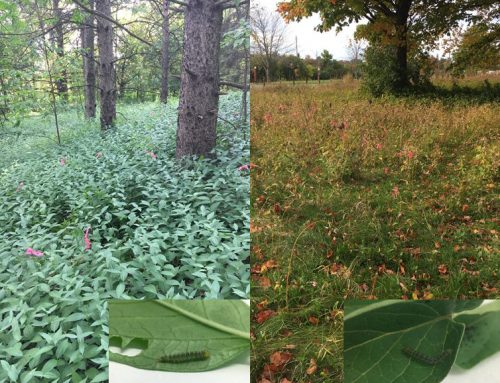by Christine Hanrahan
Winter may seem an odd time to be thinking of butterflies, but on your winter walk, you may actually be passing a butterfly or two, without knowing it. How can that be, you may ask? Well, our overwintering butterflies frequently find hibernation sites under loose bark of trees or in crevices, cavities, and even caves. I’ve also seen butterflies emerging in spring from the eaves of old buildings.
Many folk find it astonishing that butterflies, which we think of as fragile creatures, can survive our cold winters. Not all butterflies overwinter as adults, of course. In fact, only a few do so in this region, but they fascinate us because of their ability to withstand snow and freezing temperatures. Around Ottawa, Mourning Cloak (Nymphalis antiopa), Eastern Comma (Polygonia comma), Green Comma (Polygonia faunus), Question Mark (Polygonia interrogationis), Milbert’s Tortoiseshell (Nymphalis milberti), and Compton Tortoiseshell (Nymphalis vau-album) overwinter in their adult form. Other species overwinter as adults further south, the most familiar example being the Monarch butterfly which winters in Mexico.
How do these delicate butterflies survive the winter? In a word, diapause. As explained by James and Nunnallee (2011), hibernating adults are dormant “and in a physiological state called diapause, characterized by a lowered metabolic rate and radical biochemical changes. Diapause is different from simple dormancy or inactivity as occurs in butterflies and their immature stages during cool periods in spring and autumn or overnight. It is a rigidly controlled physiological mechanism that is genetically fixed or induced by environmental cues.”
Before hibernating, these adult butterflies fatten up by feeding voraciously, often on rotting fruit and sap. This is no different from what hibernating mammals do (think of bears gorging on food to put on fat for the long winter months).
Warming weather encourages butterflies to become active again, even for just a brief period. During the very early, warm spring of 2010, I found butterflies taking advantage of the warmth in mid-March. Likewise, during the unusual heatwave of mid-March, 2012, when the temperature hit +30, I saw several Mourning Cloaks fluttering around the woods. But when the temperatures cooled again, they vanished until the next warm spell.
The most common species that I see, almost without fail, as soon as we have a few warm days in early spring are Mourning Cloak, Eastern Comma, and Compton Tortoiseshell – sometimes all three in the same general vicinity when walking through woodland sites.
How do other local butterfly species spend the winter? Most do so in the larval (caterpillar) stage, but some overwinter as pupae and some, such as hairstreaks and the European Skipper (Thymelicus lineola) in the egg stage. Just as it seems amazing that adult butterflies can survive our frigid winters, it seems to me equally miraculous that larvae and pupae can withstand the rigours of cold weather.
Last winter (2011/2012), I kept two Black Swallowtail (Papilio polyxenes) in a glass aquarium in my garden shed. I didn’t believe that the seemingly desiccated looking pupae could really become butterflies, but they did. In late April, I brought the aquarium outside into the garden and, on 26 May, a female Black Swallowtail emerged, followed a week later by a male from the second pupa. Like overwintering adults, larvae and pupae also prepare for hibernation. “By changing their physiology, butterflies, or their eggs, larvae, or pupae, are able to survive the winter for months in a state of suspended animation.” (James and Nunnallee, 2011)
Next time you are on a winter walk through a woodland, remember that you may well be passing some overwintering adult butterflies, just waiting for those first warm days of spring to fly once more.
References: James, David G. And Nunnallee, David. 2011. Life histories of Cascadia Butterflies. Oregon State University Press.
- mourning cloak on 23 march 2012
- eastern comma on 16 march 2010
- compton tortoiseshell on 19 march 2010
- question mark on 30 may 2012
- Milbert’s Tortoiseshell on 27 May 2010
- mourning cloak on 8 april 2011













Great article, Christine!! Do you think that hibernacula don’t seem to work because adult butterfles are really looking for a very confined space to wedge into?
Thanks! There is little evidence that the butterfly houses sold as hibernacula, attract butterflies. Butterflies seem always to prefer really well-hidden cracks, crevices and other snug places where the insulation factor is better. Maybe they are also instinctively drawn to more natural sites which offer greater safety. Whatever the reason, it seems that butterflies simply are not drawn to the hibernacula no matter where they are placed, whether high, low, in sun or shade, in woods or in open sites, sheltered or not. But maybe someone has had the good fortune to find a butterfly using such a structure.
Well written and useful article Christine. I think the metabolic changes in these overwintering adults include producing ‘antifreeze’ chemicals in their bodies to prevent their cells from bursting in freezing temperatures, much like some frog species do to survive winter.
Here is a good article from Michigan State U on how insects survive winter which explains the process in general terms:
http://msue.anr.msu.edu/news/how_insects_survive_cold_the_potential_effect_of_a_mild_winter
claudia
I’m so glad you did this topic! I wonder if you have any tips on how to make decent overwintering sites in the home garden? It could be another post and incorporate other animals as well as butterflies.
I found 5 Milbert’s tortoiseshells wedged between the layers of a bath towel on the laundry line. The next day when it warmed up, they took off.
Christine Thanks for the write-up. I wonder about your adding Question Mark to your list of overwintering adults as the ROM field guide indicates that it is migratory and not thought to overwinter in Ontario. Could you comment on that.
Mark Olivier
Sault Ste Marie, ON
I found what I believe is a compton tortoiseshell on my porch. We have had -20 degrees celcius for the past week. I have it in the house and don’t know what to do with it. Are you able to help me? I don’t want to send it out in the cold and don’t want to kill it with kindness either. Would really like to do what is best. I’m between Kingston and Toronto Ontario and slightly north. I would greatly appreciate any help. Thank you!